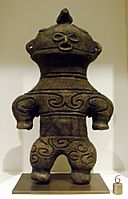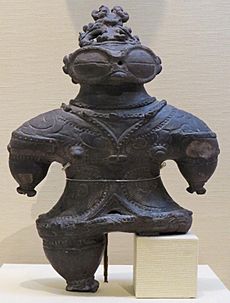Dogū facts for kids
Dogū (土偶), which means "earthen figures," are small figures shaped like people or animals. They were made from clay a very long time ago in prehistoric Japan, during the later part of the Jōmon period (about 14,000 to 400 BC).
Dogū were only made during the Jōmon period. People stopped making them when the next period, the Yayoi period, began. There are many different styles of dogū, depending on where and when they were found. Experts believe about 15,000 dogū have been found across Japan, but not in Okinawa. Most of them have been discovered in eastern Japan, and it's rare to find one in western Japan.
We don't know for sure why dogū were made. They are different from the clay haniwa figures that were used in tombs during the later Kofun period. Everyday clay items from the Jōmon period are called Jōmon pottery.
Contents
Why Were Dogū Made?
Some experts think dogū were like small models of people. They might have been used for a type of "magic" where people believed they could transfer bad things, like illnesses, into the dogū. For example, if someone was sick, they might have believed the sickness could move into the dogū. Then, the dogū would be broken, and the sickness or bad luck would go away.
What Do Dogū Look Like?
Dogū are made of clay and are usually small, about 10 to 30 centimeters tall. Most of them look like women, with big eyes, small waists, and wide hips. Many people think they might represent goddesses.
These figures often have large faces, small arms and hands, and compact bodies. Some dogū look like they are wearing goggles, or they have faces shaped like a heart. Many have marks on their faces, chests, and shoulders. These marks might show that people in the Jōmon period had tattoos or special markings made with bamboo tools.
Different Kinds of Dogū
There are several types of dogū, each with unique features:
- "Heart-shaped (or crescent-shaped eyebrow)" figures
- "Horned-owl type" figures
- "Goggle-eyed type" (shakōkidogū) figures
- "Pregnant woman type" figures
The "Goggle-Eyed" Dogū (Shakōkidogū)
The Shakōkidogū (遮光器土偶), or "goggle-eyed dogū," are very famous from the Jōmon era. When most Japanese people hear the word dogū, they often think of this specific type. The name shakōki means "light-blocking device." This is because the eyes of these figures look a lot like the snow goggles that people in cold places, like the Inuit, used to wear to protect their eyes from bright light.
Other special features of Shakōkidogū are their large bottoms, chests, and thighs. Their stomachs are often covered with patterns, and many of these patterns seem to have been painted with a red color called vermilion. The larger Shakōkidogū figures are hollow inside.
It's rare to find a Shakōkidogū that is completely whole. Most of them are missing an arm, a leg, or another body part. In many cases, it looks like these parts were cut off on purpose.
These types of dogū have been found in several important places in Japan. These include the Kamegaoka Site in Tsugaru, Aomori Prefecture; the Teshiromori Site in Morioka, Iwate Prefecture; the Ebisuda Site in Tajiri, Miyagi Prefecture; and the Izumisawa Kaizuka Site in Ishinomaki, Miyagi Prefecture. All these sites are considered Important Cultural Properties.
See also
 In Spanish: Dogū para niños
In Spanish: Dogū para niños




